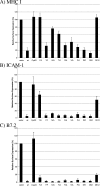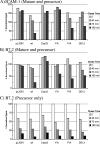The Kaposi's sarcoma-associated herpesvirus K5 E3 ubiquitin ligase modulates targets by multiple molecular mechanisms
- PMID: 17409151
- PMCID: PMC1900076
- DOI: 10.1128/JVI.02751-06
The Kaposi's sarcoma-associated herpesvirus K5 E3 ubiquitin ligase modulates targets by multiple molecular mechanisms
Abstract
Kaposi's sarcoma-associated herpesvirus encodes two highly related membrane-associated, RING-CH-containing (MARCH) family E3 ubiquitin ligases, K3 and K5, that can down regulate a variety of cell surface proteins through enhancement of their endocytosis and degradation. In this report we present data that while K5 modulation of major histocompatibility complex class I (MHC-I) closely mirrors the mechanisms used by K3, alternative molecular pathways are utilized by this E3 ligase in the down regulation of intercellular adhesion molecule 1 (ICAM-1) and B7.2. Internalization assays demonstrate that down regulation of each target can occur through increased endocytosis from the cell surface. However, mutation of a conserved tyrosine-based endocytosis motif in K5 resulted in a protein lacking the ability to direct an increased rate of MHC-I or ICAM-1 internalization but still able to down regulate B7.2 in a ubiquitin-dependent but endocytosis-independent manner. Further, mutation of two acidic clusters abolished K5-mediated MHC-I degradation while only slightly decreasing ICAM-1 or B7.2 protein destruction. This same mutant abolished detectable ubiquitylation of all targets. These data indicate that while K5 can act as an E3 ubiquitin ligase to directly mediate cell surface molecule destruction, regulation of its targets occurs through multiple pathways, including ubiquitin-independent mechanisms.
Figures








Similar articles
-
Kaposi's sarcoma-associated herpesvirus K3 and K5 ubiquitin E3 ligases have stage-specific immune evasion roles during lytic replication.J Virol. 2014 Aug;88(16):9335-49. doi: 10.1128/JVI.00873-14. Epub 2014 Jun 4. J Virol. 2014. PMID: 24899205 Free PMC article.
-
Kaposi's sarcoma-associated herpesvirus ubiquitin ligases downregulate cell surface expression of l-selectin.J Gen Virol. 2021 Nov;102(11). doi: 10.1099/jgv.0.001678. J Gen Virol. 2021. PMID: 34726593
-
[The HIV nef and the Kaposi-sarcoma-associated virus K3/K5 proteins: "parasites"of the endocytosis pathway].Med Sci (Paris). 2003 Jan;19(1):100-6. doi: 10.1051/medsci/2003191100. Med Sci (Paris). 2003. PMID: 12836198 Review. French.
-
Kaposi's sarcoma-associated herpesvirus K3 and K5 proteins down regulate both DC-SIGN and DC-SIGNR.PLoS One. 2013;8(2):e58056. doi: 10.1371/journal.pone.0058056. Epub 2013 Feb 27. PLoS One. 2013. PMID: 23460925 Free PMC article.
-
The trafficking and regulation of membrane receptors by the RING-CH ubiquitin E3 ligases.Exp Cell Res. 2009 May 15;315(9):1593-600. doi: 10.1016/j.yexcr.2008.10.026. Epub 2008 Nov 5. Exp Cell Res. 2009. PMID: 19013150 Review.
Cited by
-
Major histocompatibility complex class I downregulation induced by equine herpesvirus type 1 pUL56 is through dynamin-dependent endocytosis.J Virol. 2014 Nov;88(21):12802-15. doi: 10.1128/JVI.02079-14. Epub 2014 Aug 27. J Virol. 2014. PMID: 25165105 Free PMC article.
-
p120-catenin regulates VE-cadherin endocytosis and degradation induced by the Kaposi sarcoma-associated ubiquitin ligase K5.Mol Biol Cell. 2017 Jan 1;28(1):30-40. doi: 10.1091/mbc.E16-06-0459. Epub 2016 Oct 26. Mol Biol Cell. 2017. PMID: 27798235 Free PMC article.
-
Restoration of immune surface molecules in Kaposi sarcoma-associated herpes virus infected cells by lenalidomide and pomalidomide.Oncotarget. 2017 May 17;8(31):50342-50358. doi: 10.18632/oncotarget.17960. eCollection 2017 Aug 1. Oncotarget. 2017. PMID: 28881567 Free PMC article.
-
Engineering Tolerance toward Allogeneic CAR-T Cells by Regulation of MHC Surface Expression with Human Herpes Virus-8 Proteins.Mol Ther. 2021 Feb 3;29(2):718-733. doi: 10.1016/j.ymthe.2020.10.019. Epub 2020 Oct 22. Mol Ther. 2021. PMID: 33554868 Free PMC article.
-
Kaposi's sarcoma-associated herpesvirus K3 and K5 ubiquitin E3 ligases have stage-specific immune evasion roles during lytic replication.J Virol. 2014 Aug;88(16):9335-49. doi: 10.1128/JVI.00873-14. Epub 2014 Jun 4. J Virol. 2014. PMID: 24899205 Free PMC article.
References
Publication types
MeSH terms
Substances
Grants and funding
LinkOut - more resources
Full Text Sources
Research Materials
Miscellaneous

